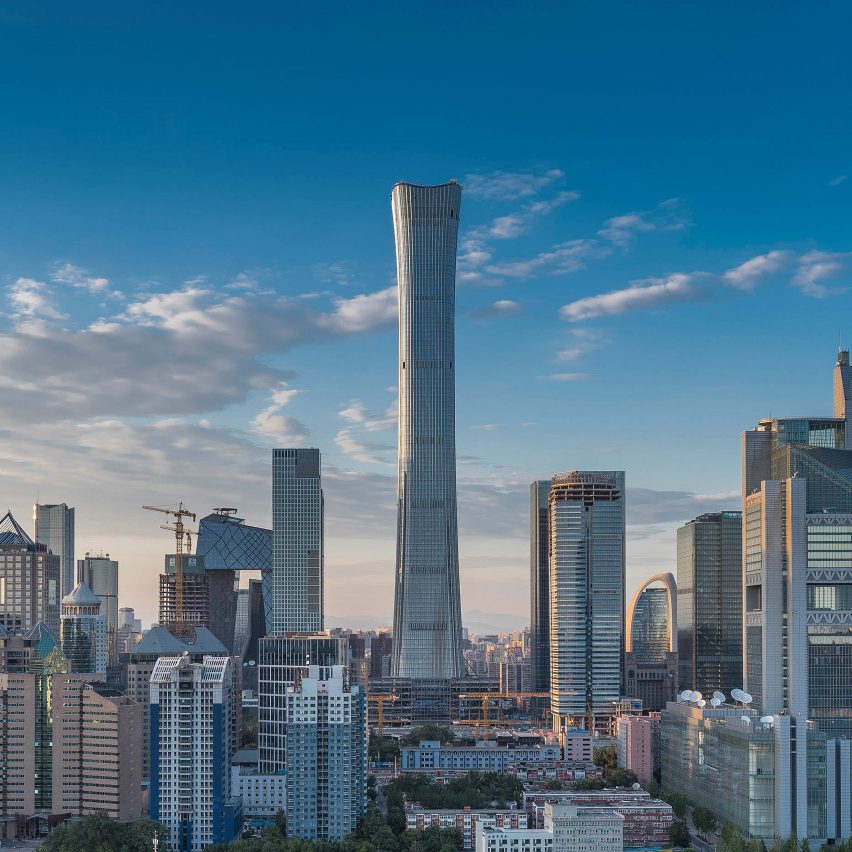
The Chinese government has issued a decree "strictly prohibiting" the plagiarism of buildings in the country and severely limiting the construction of supertall skyscrapers.
The new policy, released on the Ministry of Housing and Urban-Rural Development's website, sets a wide range of measures designed to strengthen architectural standards in the country.
It bans "copycat behaviour", states that skyscrapers over 500 metres "are not allowed", buildings over 250 metres should be "strictly restricted", and establishes the role of chief architects in its cities.
"To embody the spirit of the city, to show the style of the times, and to highlight Chinese characteristics, we hereby notify the relevant matters as follows," stated the policy, which Dezeen has translated from the original Chinese.
"Copycat behaviour strictly prohibited"
The policy provides guidance on the design and construction of major buildings including "municipal stadiums, exhibition halls, museums, and grand theatres".
For these large-scale projects "building plagiarism, imitation, and copycat behaviour are strictly prohibited," said the policy.
In the past, numerous monuments and buildings constructed in China have been direct replicas of those in Europe. London's Tower Bridge, Paris' Arc de Triomphe, Sydney's Opera House and the Eiffel Tower have all been recreated in the country.
Le Corbusier's Ronchamp Chapel was also recreated in Zhengzhou, while more recently Zaha Hadid's Wangjing Soho complex was copied by a developer in Chongqing.
This policy seems to spell an end for this trend in the country.
"Buildings over 500 metres are not allowed to be built"
The policy's guidance on large-scale projects also aims to restrict the widespread construction of skyscrapers in the country, with a focus on the tallest landmark buildings.
The government will "strictly restrict the blind planning and construction of super high-rise skyscrapers," said the policy.
"Generally, new buildings over 500 metres are not allowed to be built," it continued.
The policy also states that the country will "strictly restrict the construction of new buildings over 250 metres".
Last year was a record year for the construction of supertall skyscrapers – buildings over 300 metres – with the 530-metre-high Tianjin CTF Finance Centre by SOM the tallest tower constructed. In total,l 57 buildings over 200 metres were completed in China in 2019 according to the Council on Tall Buildings and Urban Habitat.
The policy also highlights that new skyscrapers should have a focus on fire protection, earthquake resistance, and energy saving.
Restrict construction of "strange buildings"
Along with a focus on landmark schemes and skyscrapers, the policy aims to "strengthen the guidance" on architectural style across the country.
"Architectural designs must conform to urban design requirements in terms of shape, colour, volume, height and space environment," said the policy.
It also states that officials must "comprehensively carry out urban physical examinations, and promptly remediate various 'urban diseases' including strange buildings".
Officials are also tasked with organising architectural reviews, while the Ministry of Housing and Urban-Rural Development will establish the role of chief architects in cities across China.
This advice aligns with views expressed by president Xi Jinping, who called for an end to "weird architecture" during a talk in 2014. This was followed by a directive in 2016 banning "oversized, xenocentric and weird" architecture.
During an interview with Dezeen, MAD co-founder Ma Yansong stated that Chinese cities should draw more from the country's traditional architecture.
The post China bans copycat architecture and restricts supertall skyscrapers appeared first on Dezeen.
from Dezeen https://ift.tt/3dIavSJ

No comments:
Post a Comment